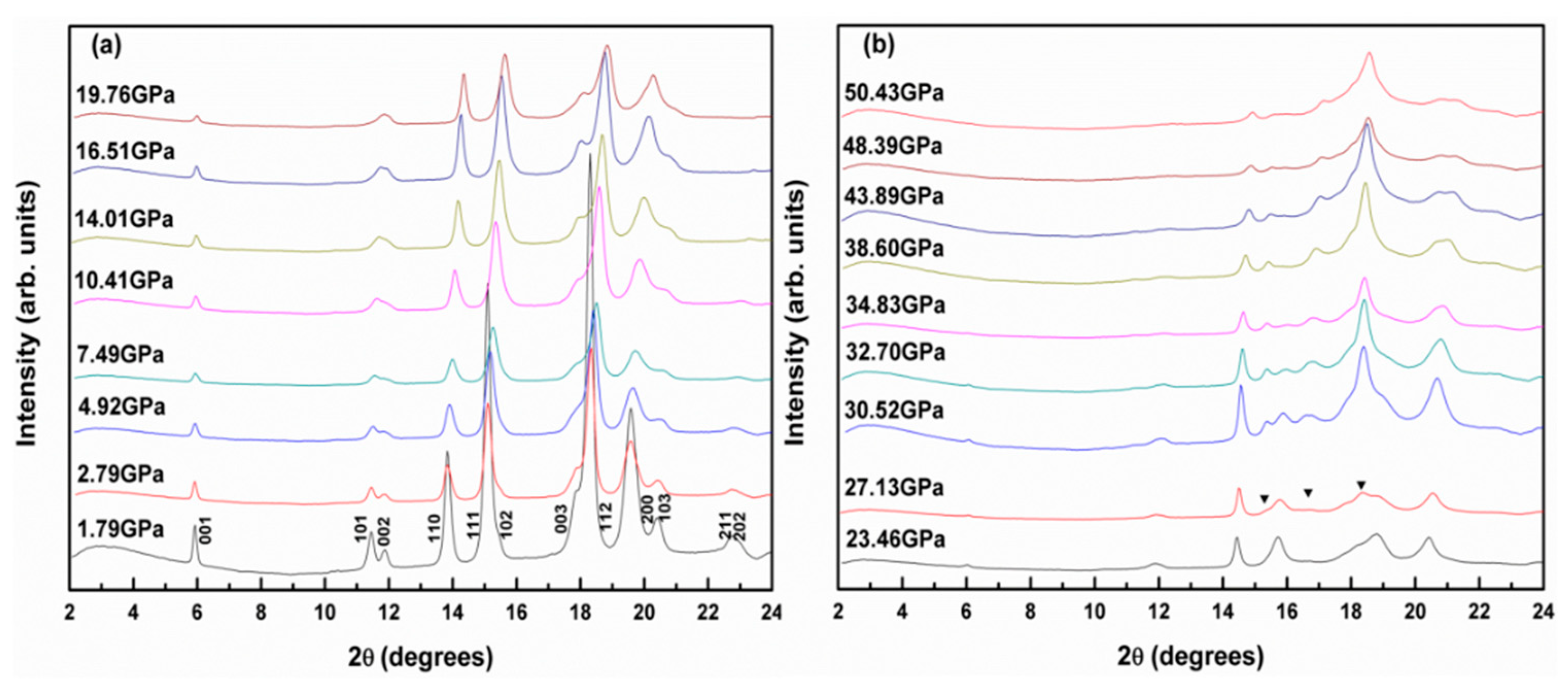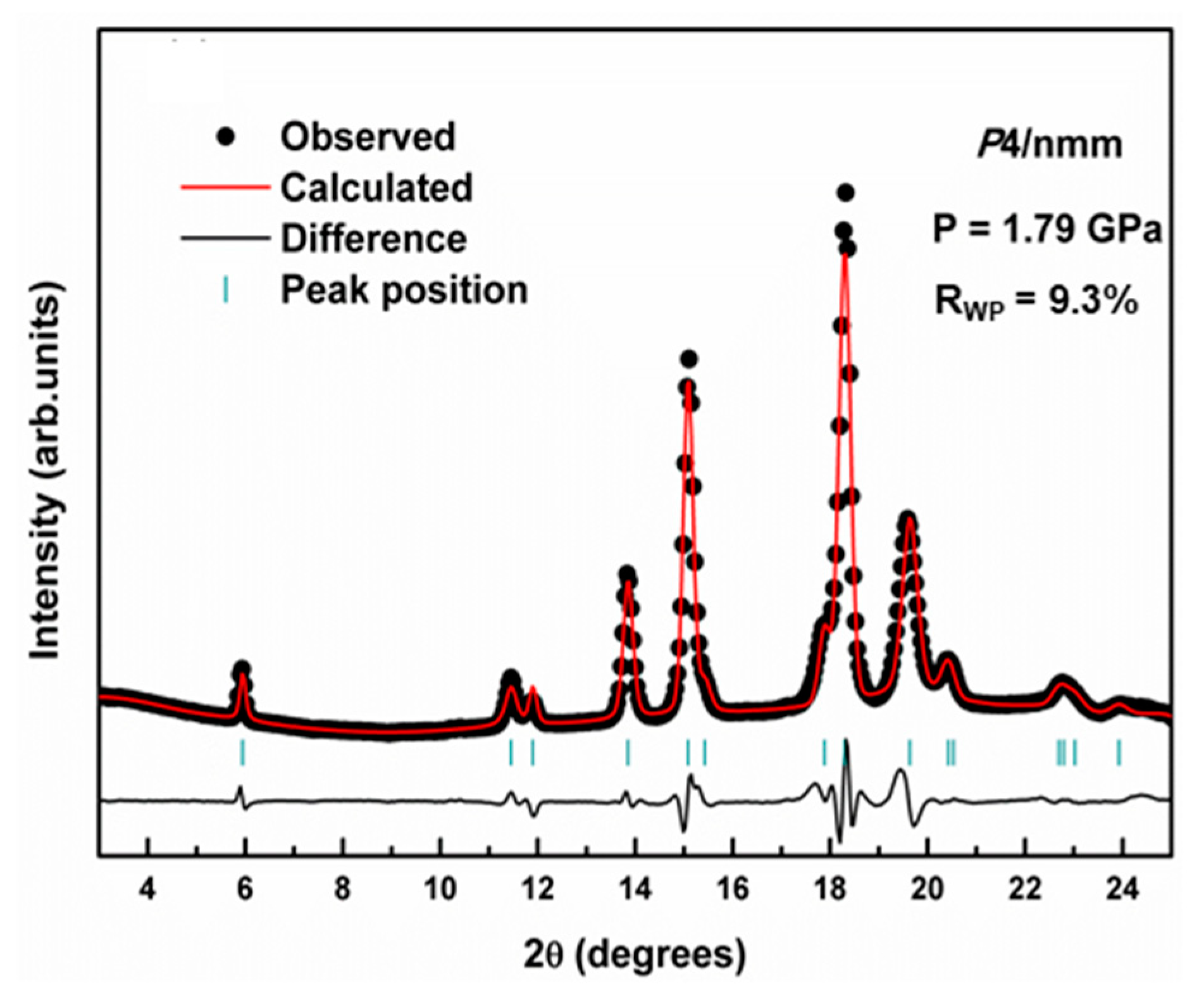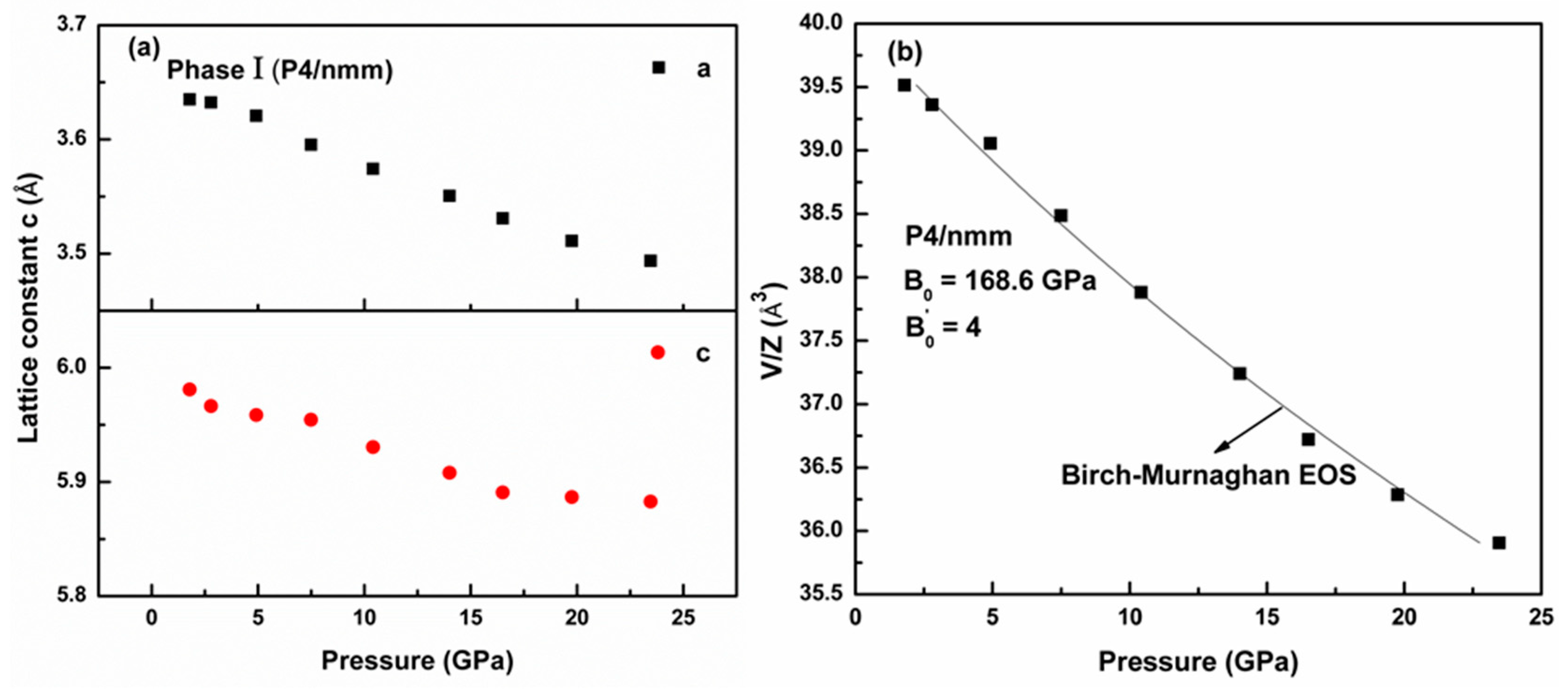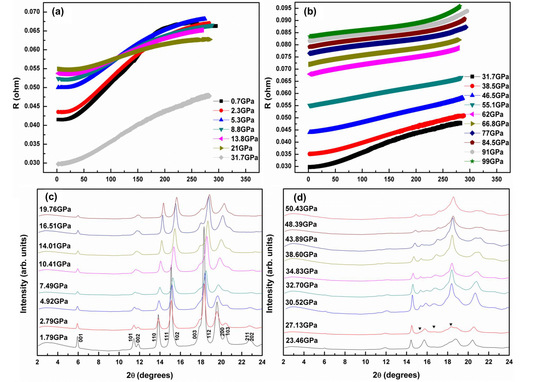Crystal Growth and Investigation of High-Pressure Physical Properties of Fe2As
Abstract
1. Introduction
2. Materials and Methods
3. Results and Discussion
4. Conclusions
Author Contributions
Funding
Conflicts of Interest
References
- Kamihara, Y.; Watanabe, T.; Hirano, M.; Hosono, H. Iron-based layered superconductor La[O1−xFx]FeAs (x = 0.05–0.12) with Tc = 26 K. J. Am. Chem. Soc. 2008, 130, 3296–3297. [Google Scholar] [CrossRef] [PubMed]
- Takahashi, H.; Igawa, K.; Arii, K.; Kamihara, Y.; Hirano, M.; Hosono, H. Superconductivity at 43K in an iron-based layered compound LaO1−xFxFeAs. Nature 2008, 453, 376–378. [Google Scholar] [CrossRef] [PubMed]
- Chen, X.H.; Wu, T.; Wu, G.; Liu, R.H.; Chen, H.; Fang, D.F. Superconductivity at 43 K in SmFeAsO1−xFx. Nature 2008, 453, 761–762. [Google Scholar] [CrossRef] [PubMed]
- Ren, Z.A.; Lu, W.; Yang, J.; Yi, W.; Shen, X.L.; Zheng, C.; Che, G.C.; Dong, X.L.; Sun, L.L.; Zhou, F.; et al. Superconductivity at 55 K in iron-based F-doped layered quaternary compound Sm[O1−xFx]FeAs. Chin. Phys. Lett. 2008, 25, 2215–2216. [Google Scholar]
- Chen, G.F.; Li, Z.; Wu, D.; Li, G.; Hu, W.Z.; Dong, J.; Zheng, P.; Luo, J.L.; Wang, N.L. Superconductivity at 41K and its competition with spin-density-wave instability in layered CeO1−xFxFeAs. Phys. Rev. Lett. 2008, 100, 247002. [Google Scholar] [CrossRef]
- Rotter, M.; Tegel, M.; Johrendt, D. Superconductivity at 38 K in the iron arsenide (Ba1−xKx)Fe2As2. Phys. Rev. Lett. 2008, 101, 107006. [Google Scholar] [CrossRef]
- Hsu, F.C.; Luo, J.Y.; Yeh, K.W.; Chen, T.K.; Huang, T.W.; Wu, P.M.; Lee, Y.C.; Huang, Y.L.; Chu, Y.Y.; Yan, D.C.; et al. Superconductivity in the PbO-type structure alpha-FeSe. Proc. Natl. Acad. Sci. USA 2008, 105, 14262–14264. [Google Scholar] [CrossRef]
- Wang, X.C.; Liu, Q.Q.; Lv, Q.Q.; Gao, W.B.; Yang, L.X.; Yu, R.C.; Li, F.Y.; Jin, C.Q. The superconductivity at 18 K in LiFeAs system. Solid State Commun. 2008, 148, 538–540. [Google Scholar] [CrossRef]
- Sefat, A.S.; Jin, R.; McGuire, M.A.; Sales, B.C.; Singh, D.J.; Mandrus, D. Superconductivity at 22 K in Co-Doped BaFe2As2 Crystals. Phys. Rev. Lett. 2008, 101, 117004. [Google Scholar] [CrossRef]
- Torikachvili, M.S.; Bud’ko, S.L.; Ni, N.; Canfield, P.C. Pressure Induced Superconductivity in CaFe2As2. Phys. Rev. Lett. 2008, 101, 057006. [Google Scholar] [CrossRef]
- Igawa, K.; Okada, H.; Takahashi, H.; Matsuishi, S.; Kamihara, Y.; Hirano, M.; Hosono, H.; Matsubayashi, K.; Uwatoko, Y. Pressure-Induced Superconductivity in Iron Pnictide Compound SrFe2As2. J. Phys. Soc. Jpn. 2009, 78, 025001. [Google Scholar] [CrossRef]
- Matsubayashi, K.; Katayama, N.; Ohgushi, K.; Yamada, A.; Munakata, K.; Matsumoto, T.; Uwatoko, Y. Intrinsic Properties of AFe2As2 (A = Ba, Sr) Single Crystal under Highly Hydrostatic Pressure Conditions. J. Phys. Soc. Jpn. 2009, 78, 073706. [Google Scholar] [CrossRef]
- Zhang, P.; Wang, Z.J.; Wu, X.X.; Yaji, K.; Ishida, Y.; Kohama, Y.; Dai, G.Y.; Sun, Y.; Bareille, C.; Kuroda, K.; et al. Multiple topological states in iron-based superconductors. Nat. Phys. 2019, 15, 41–47. [Google Scholar] [CrossRef]
- Yin, J.X.; Zhang, S.S.; Dai, G.Y.; Zhao, Y.Y.; Kreisel, A.; Macam, G.; Wu, X.X.; Miao, H.; Huang, Z.Q.; Martiny, J.H.J.; et al. Quantum phase transition of correlated iron-based superconductivity in LiFe1−xCoxAs. Phys. Rev. Lett. 2019, 123, 217004. [Google Scholar] [CrossRef] [PubMed]
- Xu, Z.; Dai, G.Y.; Li, Y.; Yin, Z.P.; Rong, Y.; Tian, L.; Liu, P.P.; Wang, H.; Xing, L.Y.; Wei, Y.; et al. Strong local moment antiferromagnetic spin fluctuations in V-doped LiFeAs. npj Quantum Mater. 2020, 5, 11. [Google Scholar] [CrossRef]
- Katsuraki, H.; Achiwa, N. The Magnetic structure of Fe2As. J. Phys. Soc. Jpn. 1966, 21, 2238–2243. [Google Scholar] [CrossRef]
- Zocco, D.A.; Tutun, D.Y.; Hamlin, J.J.; Jeffries, J.R.; Weir, S.T.; Vohra, Y.K.; Maple, M.B. High pressure transport studies of the LiFeAs analogs CuFeTe2 and Fe2As. Supercond. Sci. Technol. 2012, 25, 084018. [Google Scholar] [CrossRef]
- Takeshita, N.; Iyo, A.; Ishida, S.; Eisaki, H.; Yoshida, Y. Electrical resistivity of FeAs, FeAs2 and Fe2As at homogeneous high pressures. J. Phys. Conf. Ser. 2017, 950, 042024. [Google Scholar] [CrossRef]
- Zhang, J.L.; Zhang, S.J.; Weng, H.M.; Zhang, W.; Yang, L.X.; Liu, Q.Q.; Feng, S.M.; Wang, X.C.; Yu, R.C.; Cao, L.Z.; et al. Pressure-induced superconductivity in topological parent compound Bi2Te3. Proc. Natl. Acad. Sci. USA 2011, 108, 24–28. [Google Scholar] [CrossRef]
- Zhang, S.J.; Zhang, J.L.; Yu, X.H.; Zhu, J.; Kong, P.P.; Feng, S.M.; Liu, Q.Q.; Yang, L.X.; Wang, X.C.; Cao, L.Z.; et al. The comprehensive phase evolution for Bi2Te3 topological compound as function of pressure. J. Appl. Phys. 2012, 111, 112630. [Google Scholar] [CrossRef]
- Mao, H.; Xu, J.A.; Bell, P. Calibration of the ruby pressure gauge to 800 kbar under quasi-hydrostatic conditions. J. Geophys. Res. Solid Earth Plantets 1986, 91, 4673–4676. [Google Scholar] [CrossRef]
- Hammersley, A.P.; Svensson, S.O.; Hanfland, M.; Fitch, A.N.; Hausermann, D. Two-dimensional detector software: From real detector to idealized image or two-theta scan. Int. J. High Press. Res. 1996, 14, 235–248. [Google Scholar] [CrossRef]
- Toby, B.H. EXPGUI, a graphical user interface for GSAS. J. Appl. Cryst. 2001, 34, 210–213. [Google Scholar] [CrossRef]
- Nuss, J.; Wedig, U.; Jansen, M. Geometric variations and electron localizations in intermetallics: PbFCl type compounds. Z. Krist. 2006, 221, 554–562. [Google Scholar] [CrossRef]
- Kong, P.P.; Zhang, J.L.; Zhang, S.J.; Zhu, J.; Liu, Q.Q.; Yu, R.C.; Fang, Z.; Jin, C.Q.; Yang, W.G.; Yu, X.H.; et al. Superconductivity of the topological insulator Bi2Se3 at high pressure. J. Phys. Condens. Matter 2013, 25, 362204. [Google Scholar] [CrossRef]
- Zhu, J.; Zhang, J.L.; Kong, P.P.; Zhang, S.J.; Yu, X.H.; Zhu, J.L.; Liu, Q.Q.; Li, X.; Yu, R.C.; Ahuja, R.; et al. Superconductivity in Topological Insulator Sb2Te3 Induced by Pressure. Sci. Rep. 2013, 3, 2016. [Google Scholar] [CrossRef]
- Liu, Y.; Long, Y.J.; Zhao, L.X.; Nie, S.M.; Zhang, S.J.; Weng, Y.X.; Jin, M.L.; Li, W.M.; Liu, Q.Q.; Long, Y.W.; et al. Superconductivity in HfTe5 across weak to strong topological insulator transition induced via pressures. Sci. Rep. 2017, 7, 44367. [Google Scholar] [CrossRef]
- Jin, M.L.; Sun, F.; Xing, L.Y.; Zhang, S.J.; Feng, S.M.; Kong, P.P.; Li, W.M.; Wang, X.C.; Zhu, J.L.; Long, Y.W.; et al. Superconductivity Bordering Rashba Type Topological Transition. Sci. Rep. 2017, 7, 39699. [Google Scholar] [CrossRef]
- Okada, H.; Igawa, K.; Takahashi, H.; Kamihara, Y.; Hirano, M.; Hosono, H.; Matsubayashi, K.; Uwatoko, Y. Superconductivity under high pressure in LaFeAsO. J. Phys. Soc. Jpn. 2008, 77, 113712. [Google Scholar] [CrossRef]
- Mani, A.; Ghosh, N.; Paulraj, S.; Bharathi, A.; Sundar, C.S. Pressure-induced superconductivity in BaFe2As2 single crystal. Europhys. Lett. 2009, 87, 17004. [Google Scholar] [CrossRef]
- Wu, J.J.; Lin, J.F.; Wang, X.C.; Liu, Q.Q.; Zhu, J.L.; Xiao, Y.M.; Chow, P.; Jin, C.Q. Pressure-decoupled magnetic and structural transitions of the parent compound of iron-based 122 superconductors BaFe2As2. Proc. Natl. Acad. Sci. USA 2013, 110, 17263–17266. [Google Scholar] [CrossRef] [PubMed]
- Wang, X.C.; Zhang, S.J.; Liu, Q.Q.; Deng, Z.; Lv, Y.X.; Zhu, J.L.; Feng, S.M.; Jin, C.Q. Effect of pressure on a “111”-type iron pnictide superconductor. High Press. Res. 2011, 31, 7–12. [Google Scholar] [CrossRef]
- Mizuguchi, Y.; Tomioka, F.; Tsuda, S.; Yamaguchi, T.; Takano, Y. Superconductivity at 27 K in tetragonal FeSe under high pressure. Appl. Phys. Lett. 2008, 93, 152505. [Google Scholar] [CrossRef]
- Chen, Z.J.; Xu, G.B.; Yan, J.G.; Kuang, Z.; Chen, T.H.; Li, D.H. First-principles investigation of mechanical and electronic properties of MFeAs (M = Cu, Li, and Na). J. Appl. Phys. 2016, 120, 235103. [Google Scholar] [CrossRef]
- Liu, Q.Q.; Yu, X.H.; Wang, X.C.; Deng, Z.; Lv, Y.X.; Zhu, J.L.; Zhang, S.J.; Liu, H.Z.; Yang, W.G.; Wang, L.; et al. Pressure-Induced isostructural phase transition and correlation of feas coordination with the superconducting properties of 111-Type Na1−xFeAs. J. Am. Chem. Soc. 2011, 133, 7892–7896. [Google Scholar] [CrossRef]
- Zhang, X.X.; Wang, Y.C.; Ma, Y.M. High pressure structures of ‘‘111’’ type iron-based superconductors predicted from first-principles. Phys. Chem. Chem. Phys. 2012, 14, 15029–15035. [Google Scholar] [CrossRef]





© 2020 by the authors. Licensee MDPI, Basel, Switzerland. This article is an open access article distributed under the terms and conditions of the Creative Commons Attribution (CC BY) license (http://creativecommons.org/licenses/by/4.0/).
Share and Cite
Dai, G.; Zhang, C.; Zhang, S.; He, X.; Ren, C.; Zhao, J.; Li, X.; Wang, X.; Jin, C. Crystal Growth and Investigation of High-Pressure Physical Properties of Fe2As. Crystals 2020, 10, 790. https://doi.org/10.3390/cryst10090790
Dai G, Zhang C, Zhang S, He X, Ren C, Zhao J, Li X, Wang X, Jin C. Crystal Growth and Investigation of High-Pressure Physical Properties of Fe2As. Crystals. 2020; 10(9):790. https://doi.org/10.3390/cryst10090790
Chicago/Turabian StyleDai, Guangyang, Changling Zhang, Sijia Zhang, Xin He, Chongwen Ren, Jianfa Zhao, Xiaodong Li, Xiancheng Wang, and Changqing Jin. 2020. "Crystal Growth and Investigation of High-Pressure Physical Properties of Fe2As" Crystals 10, no. 9: 790. https://doi.org/10.3390/cryst10090790
APA StyleDai, G., Zhang, C., Zhang, S., He, X., Ren, C., Zhao, J., Li, X., Wang, X., & Jin, C. (2020). Crystal Growth and Investigation of High-Pressure Physical Properties of Fe2As. Crystals, 10(9), 790. https://doi.org/10.3390/cryst10090790





